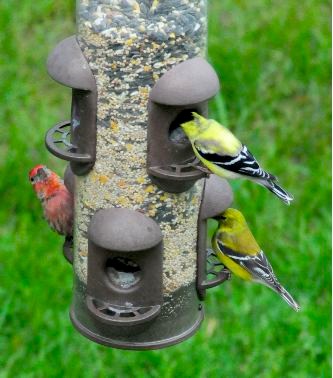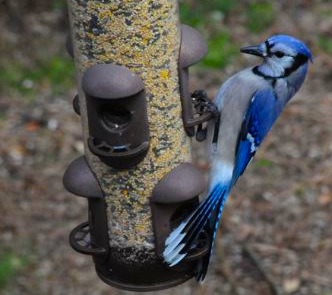-
It takes all kinds…at a tube bird feeder!
Of all the different seeds available for wild bird feeding, it seems a basic mixed seed attracts a good variety of birds. With a mixed seed in a tube bird feeder, you can expect to see all kinds!
Goldfinches and a Purple Finch share this tube bird feeder in harmony. Only seconds later, this juvenile Blue Jay stopped by for a bite to eat too.
Pretty nondescript, it’s your basic tube model. But there are some really cool tube bird feeders hand crafted by artisans, in ceramics and stoneware. The natural-themes in fun designs and sometimes vivid colors can tend to add a great focal point in the garden or landscape.
So if you’re looking to add another feeder, or a first feeder to entice feathered friends… consider a tube bird feeder for a good variety of visitors!
-
This Season for Seed Catchers!
I just don’t get it sometimes, because every year I promise myself to install seed catchers underneath my feeders, and every year I just clean up the mess below instead! For someone who does the backyard birding thing to the degree of overkill, you’d think these seed catchers would already be in place? Right now there are three heated birdbaths, ten in all! Feeding sunflower, thistle, suet, finch mix, live mealworms, peanuts, and oh…let’s not forget the squirrels! In summer we have two water wigglers, 2 misters and two birdbath drippers going too. By the way, the birds and butterflies really love the leaf misters!
Beside the unsightly mess below feeders, old seed becomes molded and poses a health hazard to the immediate bird population. Spreading fungus and airborne diseases is never good.The added platform space from a seed catcher virtually creates an additional feeder for birds who may not perch at the main feeder.
Available for 4×4 posts, standard 1-inch diameter poles, and adjustable hanging seed catchers, there’s just no more excuses for accumulated ground mess.
-
Offer nesting materials early to further entice birds
Encourage birds to nest in your yard by offering them a good variety of nesting materials. Simple things you may likely already have around your home are fantastic, items which birds will use for nest building.
Got a pet? Cat and dog hair are some favorites, as are feathers, and decorative mosses. Spanish moss, sphagnum moss, raffia and aspen fiber are perfect nesting materials birds will go for! Brightly colored cotton yarns add to the mixture also helps grab their attention. One of the tricks is to have your nesting materials out before the nesting season begins, and in plain view where birds will easily see them.
Lots of kits and fun holders are available for wild bird nesting materials. The Birdie Bell shown here actually does triple duty. It will hold fruit in summer for the more exotic, migratory birds, and seed bells or suet in winter to help sustain your regular crew. Come spring, simply fill the bell with nesting material. An item like this with year round usage is a good value. But truth be told… you can use a simple suet cage to offer nesting materials as well. Even the mesh produce bags from the grocery store (like the kind apples come in) will effectively hold nesting materials that birds can access.
So aside from the birdhouses and feeders, be sure there is a fresh water source too. Be it a creek or bird bath, all species of wild birds are drawn to water. And don’t forget: start gathering materials now that will entice feathered friends to take up residence! Happy Birding!





